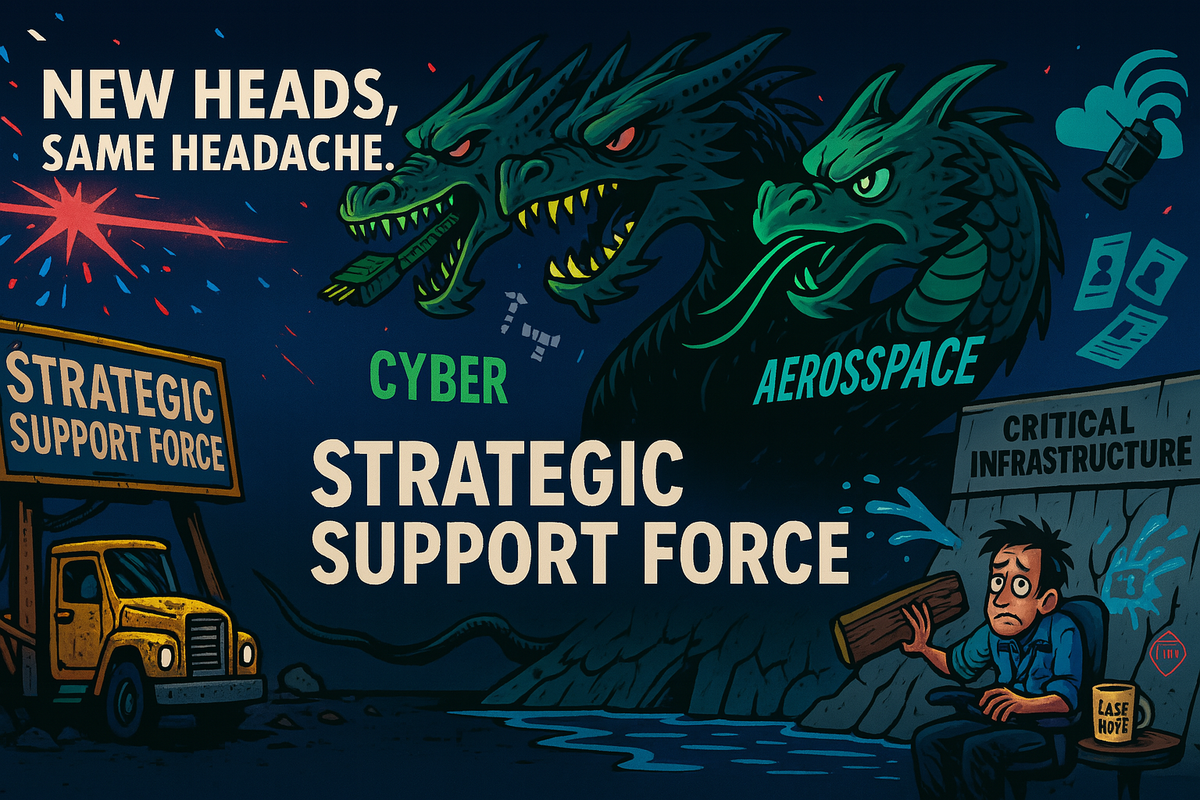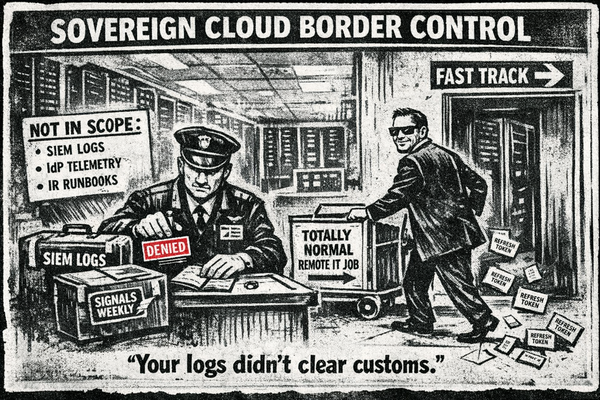PLA’s Multi-Domain Reorganization: Cyberspace, Aerospace, and Information Support Forces Reshape the Threat Landscape
In April 2024, the People’s Liberation Army (PLA) disbanded its Strategic Support Force (SSF), establishing three independent branches: the Cyberspace Force, Aerospace Force, and Information Support Force (ISF). This reorganization reflects a strategic pivot toward specialization and operation...



(Have feedback? Did something resonate with you? Did something annoy you? Just hit reply! :))
Have questions like this:
- PLA Cyberspace Force ?
- How does the PLA Cyberspace Force coordinate with other PLA branches, such as the Aerospace and Information Support Forces, in joint operations?
Does it take a chunks out of your day? Would you like help with the research?
This baseline report was thoughtfully researched and took 10 minutes.. It's meant to be a rough draft for you to enhance with the unique insights that make you an invaluable analyst.
We just did the initial grunt work..
Are you ready to level up your skillset? Get Started Here!
Did this help you? Forward it to a friend!
TL;DR
Key Points
-
- PLA’s April 2024 reorganization dissolved the Strategic Support Force (SSF), creating specialized Cyberspace, Aerospace, and Information Support Forces to enhance multi-domain operational effectiveness.
- This structural shift enables more agile, AI-driven command and control (C2) integration across cyber, space, and information domains, directly targeting U.S., Taiwan, Japan, India, and Australia.
-
- PLA’s new branches are conducting increasingly sophisticated, integrated cyber, electronic, and space-based operations against military, critical infrastructure, government, technology, and financial sectors.
- Adversaries face heightened risk from coordinated cyber espionage, electronic warfare, anti-satellite operations, and information campaigns, with Volt Typhoon exemplifying ongoing PLA activity.
-
- Allied responses include accelerated AI-enabled C2 adoption, expanded intelligence sharing (Five Eyes, Quad), and investment in asymmetric, resilient defenses for critical infrastructure.
- Success hinges on real-time detection, rapid response, and red-teaming exercises simulating PLA-style multi-domain attacks.
Executive Summary
In April 2024, the People’s Liberation Army (PLA) disbanded its Strategic Support Force (SSF), establishing three independent branches: the Cyberspace Force, Aerospace Force, and Information Support Force (ISF). This reorganization reflects a strategic pivot toward specialization and operational agility, leveraging AI, quantum computing, and big data to drive “intelligentized” warfare. The new structure centralizes command, reduces inter-service friction, and enables rapid, integrated C2 across cyber, space, and information domains.
The PLA’s Cyberspace Force now leads offensive and defensive cyber operations, the Aerospace Force commands strategic early warning and space assets, and the ISF manages information warfare and network communications. These branches are executing joint exercises and real-world campaigns—such as Volt Typhoon—demonstrating advanced cross-domain integration and targeting U.S., Taiwan, Japan, India, and Australia. Sectors at risk include military C2, critical infrastructure (energy, telecom, transportation), government, technology, and finance.
Attack vectors include cyber espionage, electronic warfare, jamming, anti-satellite operations, and information/psychological campaigns. The PLA’s AI-driven C2 platforms enable real-time synchronization of multi-domain operations, though challenges remain in areas like ballistic missile defense integration. Adversaries are responding by deploying AI-enabled SOAR platforms, expanding intelligence-sharing frameworks, and investing in deception and resilience technologies.
Short-term forecasts anticipate intensified PLA multi-domain operations, with increased use of AI-enhanced C2, spearphishing, and living-off-the-land techniques. Long-term, the PLA is likely to field autonomous, adaptive cyber and electronic warfare systems, further complicating detection and attribution. Allied defenders must prioritize joint C2 integration, intelligence sharing, and red-teaming to counter evolving PLA tactics and maintain strategic advantage.
Research & Attribution
Historical Context
In April 2024, the PLA dissolved its Strategic Support Force (SSF), which had previously integrated space, cyber, and information warfare capabilities, and established three distinct branches: the Cyberspace Force, Aerospace Force, and Information Support Force (ISF). This reorganization was driven by the need to enhance specialization and operational effectiveness in multi-domain warfare, reflecting lessons learned from ongoing global conflicts and the evolving nature of warfare. The PLA’s modernization efforts emphasize "intelligentization," leveraging AI, quantum computing, and big data to improve joint command and control (C2) and operational integration across cyber, space, air, and information domains.
Timeline
- April 19, 2024: SSF disbanded; Cyberspace Force, Aerospace Force, and ISF established as independent branches under the Central Military Commission (CMC).
- May 2024: Joint Sword-2024A exercise demonstrates cross-domain operational capabilities, including cyber and aerospace integration.
- Late 2024: Chinese leadership publicly emphasizes the strategic importance of the ISF.
- Early 2025: Continued refinement of C2 integration mechanisms and multi-domain operational coordination.
- 2024–2025: PLA conducts multiple joint exercises and operational deployments focusing on cyber, space, and information warfare, enhancing interoperability and command integration.
Origin
The PLA Cyberspace Force and Aerospace and Information Support Forces originated from the former SSF, which was responsible for space, cyber, electronic, and information warfare. The 2024 reorganization elevated these capabilities into separate branches to address command and control challenges and improve operational effectiveness. The Aerospace Force now commands strategic early warning radars and space assets, while the Cyberspace Force focuses on offensive and defensive cyber operations. The ISF manages information warfare and network communications, supporting joint operations. This structure aligns with PLA efforts to centralize command, reduce inter-service friction, and enhance rapid decision-making in multi-domain operations.
Countries Targeted
- United States – Primary focus of PLA cyber and information operations targeting critical infrastructure and military networks.
- Taiwan – Targeted through joint exercises and information campaigns aimed at coercion and potential blockade.
- Japan – Targeted due to its alliance with the U.S. and regional security role.
- India – Increasingly targeted amid border tensions and regional competition.
- Australia – Targeted as part of broader Indo-Pacific security dynamics.
Sectors Targeted
- Military – Degrading adversary command, control, communications, and intelligence capabilities.
- Critical Infrastructure – Cyber and electronic attacks on energy, telecommunications, and transportation sectors.
- Government – Espionage and influence operations targeting policy and decision-making.
- Technology – Intellectual property theft and disruption of defense-related industries.
- Financial – Operations aimed at economic disruption and destabilization.
Motivation
The PLA aims to achieve information dominance and multi-domain superiority to support China's strategic objectives, including reunification with Taiwan, regional influence, and countering U.S. military presence. The coordination between the Cyberspace Force and Aerospace and Information Support Forces enhances the PLA’s ability to conduct integrated cyber, space, and information operations that disrupt adversary capabilities, protect Chinese assets, and project power effectively.
Attack Types
- Cyber espionage and intrusion campaigns targeting military and critical infrastructure.
- Electronic warfare and jamming to degrade adversary communications and sensors.
- Space-based reconnaissance and potential anti-satellite operations.
- Information warfare including influence and psychological operations.
- Joint blockade and multi-domain denial operations integrating cyber and aerospace capabilities.
Command and Control Integration
The PLA has developed enhanced C2 integration mechanisms to operationalize joint capabilities between the Cyberspace Force, Aerospace Force, and ISF. The Aerospace Force, elevated to a theater command deputy commander grade, now commands strategic early warning radars and space assets previously dispersed across services, improving system integration and rapid decision-making. Joint exercises such as Joint Sword-2024A have demonstrated the use of integrated C2 platforms that leverage AI-driven decision support tools to synchronize cyber, space, and information operations in real-time. However, challenges remain, such as the division of ballistic missile defense responsibilities between the Aerospace Force and Air Force, which may complicate full integration. The PLA is actively addressing interoperability issues through doctrinal updates and technological investments in joint C2 systems to enable seamless multi-domain operations.
Broader Strategic Implications and Adversary Response
The PLA’s reorganization and enhanced joint operations have significant implications for Indo-Pacific and global security. The U.S., Japan, and Taiwan have responded by strengthening their cyber defenses, enhancing joint military exercises, and deepening alliance coordination to counter PLA multi-domain threats. The U.S. Department of Defense has increased focus on integrated cyber and space defense capabilities, while Japan and Taiwan have accelerated investments in asymmetric warfare and information resilience. These developments contribute to an evolving security environment marked by heightened competition, increased risk of escalation, and the need for robust deterrence and crisis management mechanisms. The PLA’s emphasis on rapid, integrated C2 and multi-domain operations challenges regional stability and compels adversaries to adapt their military postures and strategic planning accordingly.
Recommendations, Actions, Suggested Pivots, Forecasts and Next Steps
(Subscribers Only)


![[FORECAST] CoPhish: The Microsoft Copilot Link That Hands Over Your OAuth Tokens](/content/images/size/w600/2026/01/z-1.png)

![[DEEP RESEARCH] Token Factory: The 5 Costliest US Breaches of 2025](/content/images/size/w600/2026/01/z.png)
